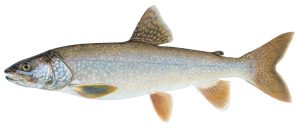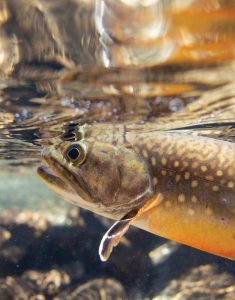
02 Feb When is a Trout not a Trout?
Decades ago, I drew a coveted Shiras moose tag for the mountains north of Cooke City. A friend and I headed uphill by vehicle until I thought the habitat looked right, and then packed into a nearby lake. Most lakes on the Beartooth Plateau contain fish of some kind, and we had brought along fly rods and basic flies. By the time we had camp set up it was too late in the day to hunt, so we rigged up our fishing gear and started casting streamers into the lake.

Lake Trout
If the lake held any fish at all, I expected them to be small backcountry cutthroat trout. When a fish struck after a dozen casts, I felt more weight on my line than I expected from a scaled-down version of Montana’s state fish. When I eased the fish into the shallows, I received an unexpected jolt of déjà vu. The fish was a 15-inch brook trout dressed up in the autumn pre-spawning colors that make it one of North America’s most beautiful freshwater fish. The ivory-white leading edges of its pectoral fins glowing back at me from the crystalline water transported me back to New York’s Adirondack Mountains and the classic brook trout water I fished as a kid.
And to think: The fish at my feet really wasn’t even a trout.

The dark body and light spots on this fish identify it as a char. The fins’ white edges and the purple spots with crimson centers identify it as a brook trout. Photographed by Don & Lori Thomas
Technical distinction between trout and their relatives in the char family (genus Salvelinus) requires inspection of the teeth and counting scales along the lateral line. Fortunately, there is an easier way to make the call. Trout have light bodies with dark spots, while char have dark bodies with light spots. This simple rule applies throughout North America.
Save for cutthroats, the trout that have made Montana a famous fly-fishing destination don’t really belong here. Rainbow trout (genus Oncorhynchus) derive from North Pacific ancestors and never made it across the continental divide on their own power. Brown trout (genus Trutta) are an Old-World species that wouldn’t have crossed the Atlantic if American anglers hadn’t wanted them to.
The situation is more complicated with regard to Montana’s char species. All three deceptively include the word “trout” in their common name. One is clearly a native, one clearly isn’t, and the origin story of the third remains confusing. One provides widespread angling opportunities, one is listed under the Endangered Species Act, and the third has proved to be an ecological disaster for some of our most iconic wildlife. Let’s review the cast of characters.
BULL TROUT
My introduction to Montana’s char began way back in the 1950s, when my father and I launched our canoe from a Glacier National Park campsite and paddled all the way to the end of Bowman Lake. When we arrived at the mouth of the inlet stream, Dad noticed dark shapes holding in the current where it dissipated in the lake’s clear water.

Bull Trout
After digging through my box of flies — all of which I had tied myself — I selected a Wooly Worm, one of those grand old patterns that resembles nothing, but catches everything. The first time I got the fly to drift properly downstream to the fish, one struck immediately. The size and power of the fish felt exhilarating. Still unfamiliar with Western wildlife, we had to do some head scratching when I finally maneuvered the fish into the shallows. My father ultimately declared it a Dolly Varden. He was right … sort of.

Non-native brook trout released into Yellowstone National Park’s Firehole River in 1889 spread across Montana, often courtesy of “bucket biology.” Photographed by Fish Eye Guy Photography
The similarities among Dolly Varden, bull trout, and arctic char are so confusing that biologists have argued over their classification for years. At the time, the fish I caught in Bowman Lake actually was a Dolly Varden, since bull trout were not recognized as a separate species (S. confluensis) until 1978. While old records frequently refer to “Dolly Vardens” in western Montana, they were all really bull trout. Officially, there are no Dollies in the state.
Our only unequivocally native char, bull trout are a classic example of an indicator species, with vulnerable habitat requirements that can signal impending trouble for other wildlife when compromised. Like the proverbial canary in the coal mine, declining bull trout numbers provide early evidence of environmental degradation that can eventually affect multiple other species.

Dolly Varden
Bull trout exist in both fluvial (stream resident) and adfluvial (lake resident) populations. In late summer and early fall, mature fish make long upstream migrations to spawn in the headwaters of the Flathead and Clark Fork drainages. Their spawning habitat requirements include cold water, gravel streambeds free of silt, and deep pools with underwater structure to provide shelter for young fish. As logging, streamside development, and other human activities compromised these conditions, bull trout numbers began to decline. At the federal level they have been classified as threatened under the Endangered Species Act, and Montana now has multiple restrictions upon their recreational take (including a seasonal fishing closure on the stream where I caught my first one). Their size alone — Flathead Lake specimens can attain weights of 15 to 20 pounds — makes bull trout an attractive quarry for anglers, but those interested in catching one should study the regulations carefully before wetting a line in bull-trout water.
brook trout
The first “trout” I ever caught was an 8-inch brookie. Five years old at the time, I was dangling a worm in a suburban trickle that didn’t look capable of supporting any fish, let alone trout. After hoisting my catch ashore and scraping the dirt off its flanks to reveal a dazzling array of colorful spots, I knew I’d caught something special. “What is it?” I asked my dad, who had already arrived in response to my shouting. “Congratulations, Donnie,” he replied between puffs on his pipe. “You’ve caught a Salvelinus fontinalis.” (A scientist, he just couldn’t help himself.)

Bull Trout Crossed With Brook Trout
I spent the next decade catching native brook trout in the creeks around our rural home in upstate New York. They may have been small, but they were the most beautiful fish I’d ever seen. Then we moved to the Pacific Northwest and I didn’t see another one for years … until I moved to Montana.
Brook trout, like me, are not native to the Treasure State. But generations before my time, other transplanted Easterners evidently missed them as much as I did and decided to do something about it. Brookies released into the Firehole River in 1889 were the first non-native fish introduced to Yellowstone National Park. From there, they spread out across Montana, sometimes on their own, sometimes courtesy of “bucket biology” that would never be tolerated today.
Despite their stigma as an alien invasive species, I’ve found ways to enjoy them here. Brookies prefer colder water than most trout, and it is unusual to find one at the lower elevations our glamour species inhabit. Personally, Montana brook trout fishing means visiting obscure spring-fed ponds or hiking uphill to little-known headwater streams. These venues provide an opportunity to fish in solitude, a pleasure that is becoming hard to encounter on Montana’s famous trout water.
Those low-key expeditions offer a bonus I rarely experience when fishing for browns, rainbows, or (especially) cutthroats. I habitually release those fish, my sense of sportsmanship supported by my lack of enthusiasm for them as table fare. Brookies are another matter when caught from pristine streams, fried to a crisp, and eaten under the stars. Because of their invasive species status, I don’t even feel guilty about eating a few.
lake trout
Lake trout (S. namaycush) are outliers in this discussion for several reasons. They are the largest by far (the state record is 43 pounds). Their status as a native fish is complicated. And too many of them in the wrong place are threatening an important ecosystem.
The lake trout receiving angling attention today, in large lakes like Flathead and Fort Peck, were introduced. However, the lake trout inhabiting Waterton, St. Mary’s, and two smaller lakes in Glacier National Park appear to have arrived naturally as glaciers receded following the last ice age. These waters drain north into the Arctic, the heartland of the species. In southwestern Montana, Elk and Twin lakes also contain lake trout apparently of natural origin.
During the 1890s, the National Park Service (NPS) stocked Yellowstone’s Lewis and Shoshone lakes with lake trout. In 1994, someone caught a lake trout in Yellowstone Lake, the keystone of the local ecosystem. Since there is no natural connection between Yellowstone Lake and known lake trout water, authorities concluded that this represented an example of unauthorized — and unwise — bucket biology.
Adult lake trout are aggressive predators that predominantly feed on other fish. In Yellowstone Lake, their main menu option was native cutthroats. As lake trout numbers exploded, cutthroat numbers dropped to just 10 percent of their historic population.
Fewer cutthroats for anglers to catch was just the tip of a complex iceberg. Like many salmonids, cutthroats run upstream in the summer to reach the gravel beds and running water they need to spawn. There, they become vulnerable to a host of predators, from eagles to grizzly bears, that depend on them as a seasonal source of nutrition. Introduced lake trout do not meet this need because they spawn in the security of deep water.
Appropriately concerned about the future of Yellowstone cutthroats and the predators that depend upon them, the NPS began actively removing lake trout with gillnets. Regulations now require recreational anglers to kill any lake trout they catch. Even though netting eventually removed over 3 million lake trout, the NPS still has a long way to go in order to make Yellowstone Lake safe for the fish that belong there.
Catch them, protect them, or despise them, these three char are now an established part of Montana’s wildlife population.




No Comments